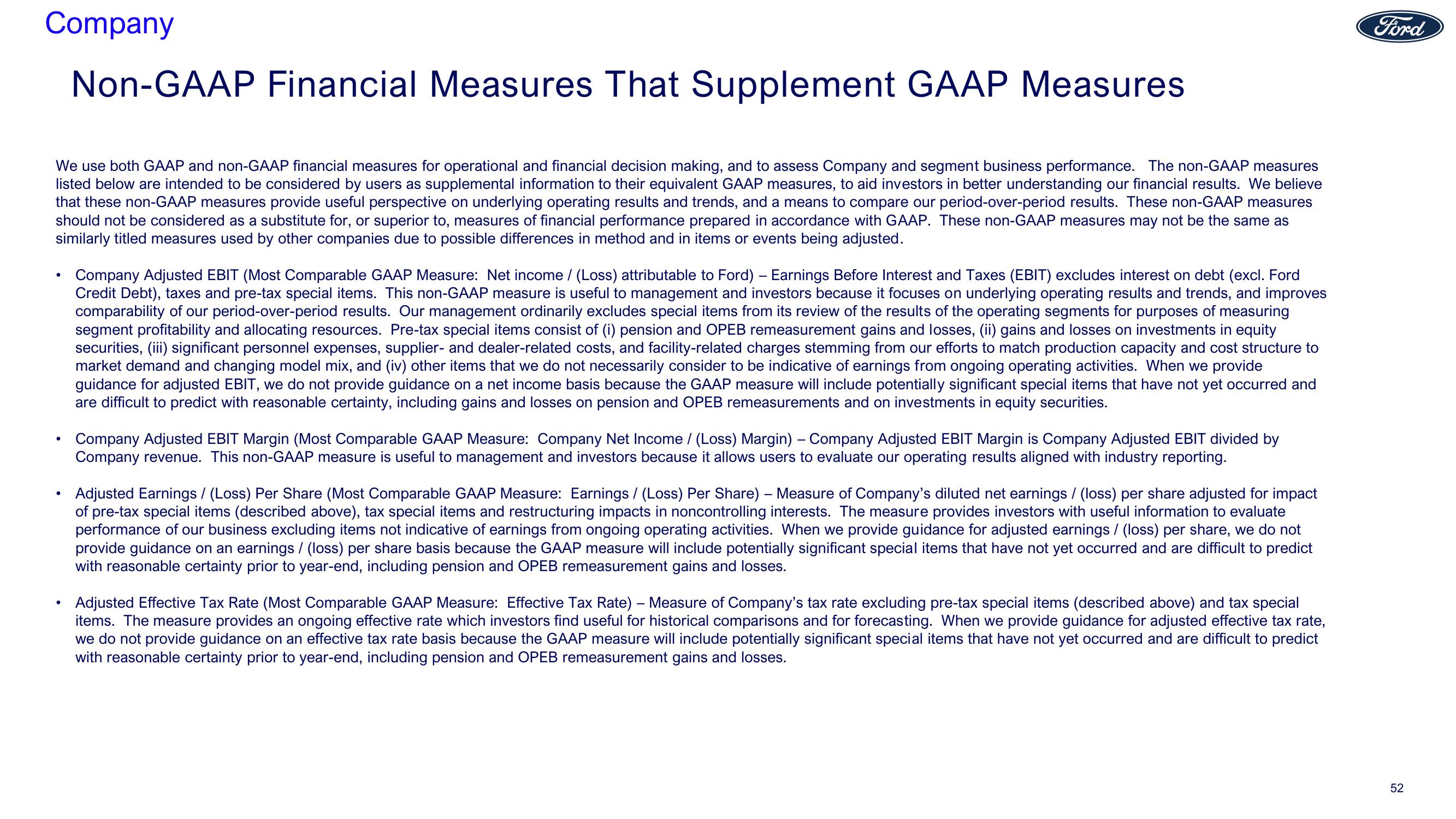Ford Investor Conference
Company
Non-GAAP Financial Measures That Supplement GAAP Measures
We use both GAAP and non-GAAP financial measures for operational and financial decision making, and to assess Company and segment business performance. The non-GAAP measures
listed below are intended to be considered by users as supplemental information to their equivalent GAAP measures, to aid investors in better understanding our financial results. We believe
that these non-GAAP measures provide useful perspective on underlying operating results and trends, and a means to compare our period-over-period results. These non-GAAP measures
should not be considered as substitute for, or superior to, measures of financial performance prepared in accordance with GAAP. These non-GAAP measures may not be the same as
similarly titled measures used by other companies due to possible differences in method and in items or events being adjusted.
●
Company Adjusted EBIT (Most Comparable GAAP Measure: Net income / (Loss) attributable to Ford) - Earnings Before Interest and Taxes (EBIT) excludes interest on debt (excl. Ford
Credit Debt), taxes and pre-tax special items. This non-GAAP measure is useful to management and investors because it focuses on underlying operating results and trends, and improves
comparability of our period-over-period results. Our management ordinarily excludes special items from its review of the results of the operating segments for purposes of measuring
segment profitability and allocating resources. Pre-tax special items consist of (i) pension and OPEB remeasurement gains and losses, (ii) gains and losses on investments in equity
securities, (iii) significant personnel expenses, supplier- and dealer-related costs, and facility-related charges stemming from our efforts to match production capacity and cost structure to
market demand and changing model mix, and (iv) other items that we do not necessarily consider to be indicative of earnings from ongoing operating activities. When we provide
guidance for adjusted EBIT, we do not provide guidance on a net income basis because the GAAP measure will include potentially significant special items that have not yet occurred and
are difficult to predict with reasonable certainty, including gains and losses on pension and OPEB remeasurements and on investments in equity securities.
Company Adjusted EBIT Margin (Most Comparable GAAP Measure: Company Net Income / (Loss) Margin) - Company Adjusted EBIT Margin is Company Adjusted EBIT divided by
Company revenue. This non-GAAP measure is useful to management and investors because it allows users to evaluate our operating results aligned with industry reporting.
Adjusted Earnings / (Loss) Per Share (Most Comparable GAAP Measure: Earnings / (Loss) Per Share) - Measure of Company's diluted net earnings / (loss) per share adjusted for impact
of pre-tax special items (described above), tax special items and restructuring impacts in noncontrolling interests. The measure provides investors with useful information to evaluate
performance of our business excluding items not indicative of earnings from ongoing operating activities. When we provide guidance for adjusted earnings / (loss) per share, we do not
provide guidance on an earnings / (loss) per share basis because the GAAP measure will include potentially significant special items that have not yet occurred and are difficult to predict
with reasonable certainty prior to year-end, including pension and OPEB remeasurement gains and losses.
Adjusted Effective Tax Rate (Most Comparable GAAP Measure: Effective Tax Rate) - Measure of Company's tax rate excluding pre-tax special items (described above) and tax special
items. The measure provides an ongoing effective rate which investors find useful for historical comparisons and for forecasting. When we provide guidance for adjusted effective tax rate,
we do not provide guidance on an effective tax rate basis because the GAAP measure will include potentially significant special items that have not yet occurred and are difficult to predict
with reasonable certainty prior to year-end, including pension and OPEB remeasurement gains and losses.
Ford
52View entire presentation